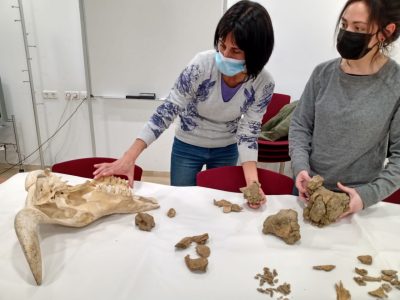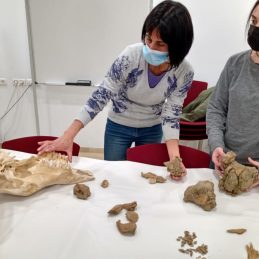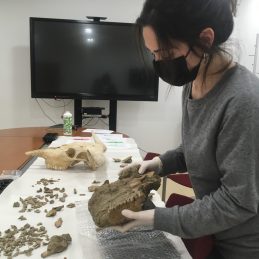
Giving life to Roman cattle through multidisciplinary research. First step: skulls reconstruction.
Do you remember the paper “What Happened in That Pit? An Archaeozoological and GIS Approach to Study an Accumulation of Animal Carcasses at the Roman Villa of Vilauba (Catalonia)” published by Lídia Colominas and the team of Museu de Banyoles on July 2021? In that paper, they discovered why there were 14 cattle carcasses disarticulated in a pit in the villa of Vilauba. Now, these researchers want to know what these cattle looked like when they were alive when they were grazing in the villa.
To achieve this, restorers Maria Molinas and Anna Montemayor, from Àbac SL, came last week to the ICAC to conclude the reconstruction of the two best-preserved skulls. This reconstruction will allow making a 3D model and start to give life to these cattle.
This is the first step of complex and multidisciplinary research that will also involve ancient DNA analyses to know the coat colour and sex, among other phenotypic characteristics, of these 14 cattle. This innovative research will allow for the first time to look at the eyes of Roman cattle.
Este es el primer paso de una investigación compleja y multidisciplinar que también implicará análisis de ADN antiguo para conocer el color y el sexo del pelaje, entre otras características fenotípicas, de las 14 piezas de ganado. Esta innovadora investigación permitirá mirar por primera vez a los ojos al ganado romano.
More news coming soon, at https://giap.icac.cat!
Follow GIAP news at Twitter @GIAP_ICAC.
Dr. Lídia Colominas is a Ramón y Cajal fellow (Ministerio de Ciencia e Innovacion) in GIAP-ICAC. This research is being carried out in the framework of the project ‘Dinàmica del poblament rural, arquitectura, economia i paisatge de les villae a l’àrea del Pla de l’Estany –Garrotxa– entre els segles II-I aC. i els segles VI-VII dC’. Quadriennals de recerca en matèria d’arqueologia i paleontología. PI: J. Tremoleda, J. Frigola.








